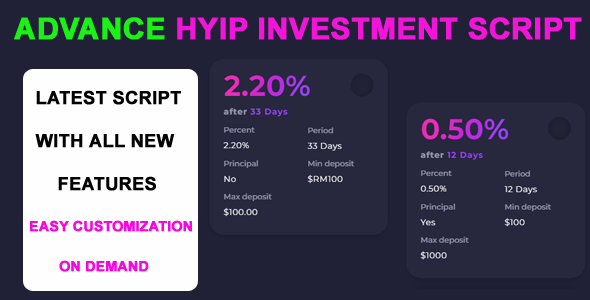
Latest Hyip Investment Script
Start your own investment website with this hyip Manager script you will get all in one ready made system include domain and hosting. Go To Buy Page
View Demo
High-yield investments
High-yield investment Script
High-yield bonds (also called junk bonds) are bonds that pay higher interest rates because they have lower credit ratings than investment-grade bonds. High-yield bonds are more likely to default, so they pay a higher yield than investment-grade bonds to compensate investors.
High-yield investments, also known as high-yield bonds or "junk bonds," refer to investment vehicles that offer higher returns compared to traditional investment options, such as government bonds or investment-grade corporate bonds. While high-yield investments can provide attractive returns, they typically come with higher risk due to the increased likelihood of default by the issuer. Here's a detailed overview of high-yield investments:
Types of High-Yield Investments:
High-Yield Bonds: High-yield bonds are issued by corporations or governments with lower credit ratings, typically below investment-grade (BBB or lower by rating agencies such as Moody's or S&P). These bonds offer higher interest rates to compensate investors for the increased risk of default.
Dividend-Paying Stocks: Some dividend-paying stocks, particularly those of companies in sectors such as real estate investment trusts (REITs), utilities, and energy, may offer higher dividend yields compared to the broader market.
Real Estate Investment Trusts (REITs): REITs are companies that own, operate, or finance income-producing real estate properties. They typically distribute a significant portion of their income to shareholders in the form of dividends, resulting in higher yields for investors.
Master Limited Partnerships (MLPs): MLPs are publicly traded partnerships that operate in sectors such as energy, natural resources, and real estate. They often offer high distribution yields to investors but come with complex tax implications.
Peer-to-Peer Lending (P2P): P2P lending platforms connect borrowers with investors willing to lend money for a return. While P2P lending can offer higher interest rates compared to traditional savings accounts or bonds, it carries risks such as borrower default and platform risk.
Risks Associated with High-Yield Investments:
Credit Risk: High-yield investments are typically issued by entities with lower credit ratings, making them more susceptible to default risk. In the event of a default, investors may face a loss of principal or missed interest payments.
Interest Rate Risk: High-yield bonds are sensitive to changes in interest rates. When interest rates rise, bond prices tend to fall, resulting in potential capital losses for investors holding high-yield bonds.
Liquidity Risk: High-yield investments may have lower liquidity compared to investment-grade securities, making it difficult to buy or sell them at desired prices, particularly during market downturns.
Market Risk: High-yield investments are subject to overall market volatility and economic conditions, which can affect their performance and investor returns.
Default and Credit Spread Risk: Changes in credit spreads, which represent the difference in yield between high-yield bonds and comparable investment-grade bonds, can impact the returns of high-yield investments.
Due Diligence and Investment Considerations:
Credit Analysis: Conduct thorough credit analysis of high-yield bonds or issuers to assess their financial health, creditworthiness, and ability to meet their debt obligations.
Diversification: Diversify high-yield investments across different issuers, sectors, and asset classes to mitigate concentration risk and spread investment risk.
Yield vs. Risk: Consider the relationship between yield and risk when evaluating high-yield investments. Higher yields often come with higher risk, so investors should assess whether the potential return justifies the level of risk undertaken.
Investment Horizon: Consider your investment horizon, risk tolerance, and financial goals when investing in high-yield investments. Longer investment horizons may help mitigate short-term market fluctuations and provide opportunities for income compounding.
Regulatory Considerations and Oversight:
High-yield investments are subject to regulatory oversight by financial authorities, such as the Securities and Exchange Commission (SEC) in the United States, to ensure transparency, investor protection, and compliance with securities laws.
Investors should be aware of regulatory requirements and disclosures associated with high-yield investments, including prospectus filings, risk disclosures, and ongoing reporting obligations by issuers.
Professional Advice and Consultation:
Investors considering high-yield investments should seek professional financial advice and consultation from qualified advisors, such as financial planners, investment advisors, or wealth managers.
Financial professionals can provide personalized guidance, risk assessment, and portfolio management strategies tailored to individual investment objectives, risk tolerance, and financial circumstances.
Overall, high-yield investments can offer attractive returns for investors seeking income generation and portfolio diversification. However, investors should carefully assess the associated risks, conduct thorough due diligence, and consult with financial professionals to make informed investment decisions aligned with their financial goals and risk tolerance.
Looking to buy High-yield investments Script?
You can get all in one readymade investment website with hyip script and domain + hosting , also include free Hyip design.
Just visit this link https://www.codeslook.com














